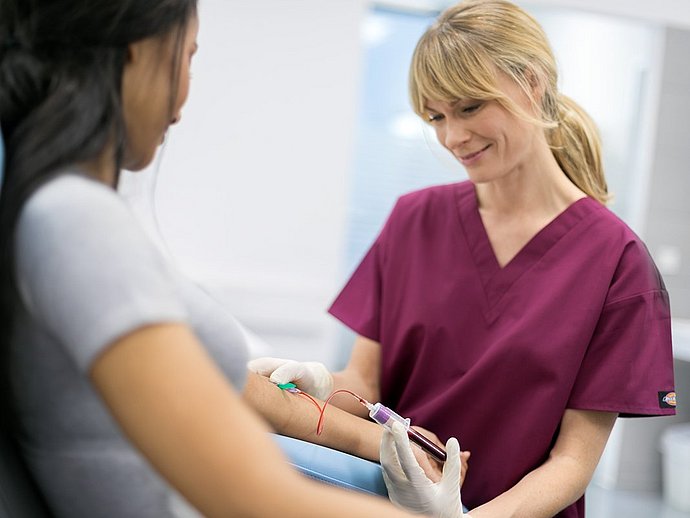Why isn't blood flowing into my tube during a blood draw?
How do you react when the vein has been selected, the skin is disinfected and dry, tourniquet has been applied, the needle is in… but there is no blood flow into the tube?
The key here is to remain calm and focused on the patient. If you remain calm, then there is no need for your patient to become anxious, which could lead to a narrowing of the blood vessels due to feelings of stress or anxiety. Ensure your tourniquet has been applied correctly. A good test of this is to be able to insert one or two fingers without the tourniquet feeling loose. The tourniquet should not be so tight as to restrict flow but should be firm enough to lead to a pooling of blood at the site.
Be sure that the needle has been inserted with the bevel upwards. If you are using a VACUETTE® needle, a quick glance at the dot on the central needle hub will confirm this.
A further measure is to check that the needle is not inserted too far, possibly too close to the vein wall, but also far enough - in best case centrally positioned - in the vein. Your actions should depend strongly on the fragility or delicacy of the vein or on how superficial the vein lies below the skin surface. Be aware that only a very flat angle (10-30°) is necessary for the ideal positioning in the vein. Carefully draw the needle back slightly and then forward again to reposition with minimal movement to prevent any jerking and possible pain for your patient and wait for blood to flow into the tube. Listen carefully – you may hear a “hissing” [1] if air is sucked in, as the vein has not been penetrated deeply enough – so adjust your needle accordingly, or in the worst case, this may mean you have to discard the tube as vacuum is lost. Always have enough equipment and material with you in case replacements are needed.
It may be helpful to maintain a friendly conversation with your patient to keep them relaxed, avoiding any comments on the patient’s veins or the ongoing procedure to prevent any anxiety spikes. Listening to your patient talk about his or her experiences could also be helpful to find out what works best.
Clear, positive communication with your patient is crucial. Be professional. If you know your game and are fully prepared, you have already created a strong basis for trust, empathy and mutual respect.
Take care that any correction measures do not take longer than a minute: bear in mind that a tourniquet should not be applied for longer than this amount of time and if the measures do not help, then remove the tourniquet and start again. You may want to examine the veins once again before recommencing the procedure using a near-infrared device to assess the conditions and adjust your chosen equipment, such as selecting a smaller needle dimension more suited to the vein size. You can also use this kind of device to identify a vein valve or to react should a vein be damaged and prevent the formation of a haematoma.
If a second attempt at venipuncture is unsuccessful, then you may need some help. At this stage, it would be beneficial to ask for support from a more experienced colleague - but keep on smiling, this is all part of the learning curve.
[1] Ruth E McCall, Phlebotomy Essentials, Seventh Edition
Safety and value, it’s in our blood
Protecting patients, clinicians and accuracy are topics to be covered in more detail here in the coming months. To ensure you don’t miss out, subscribe to the series here.
Please select your intention and contact the person who is responsible for you!
Disclaimer
This product information is addressed exclusively to healthcare professionals. Devices of Greiner Bio-One are to be used by properly trained healthcare professionals only in accordance with the relevant Instructions for Use (IFU). For a listing of indications, contraindications, precautions and warnings, please refer to the Instructions for Use which accompanies each product or is available for download from our website at www.gbo.com (Download Center). For more information contact your local Greiner Bio-One sales representative or visit our website.
All information is provided without guarantee despite careful processing. Any liability, warranty or guarantee of Greiner Bio-One GmbH is excluded. All rights, errors and changes are reserved. If not stated otherwise, Greiner Bio-One GmbH has all copyrights and/or other (user-)rights in this documents, in particular to signs such as the mentioned (word-picture-)brands and logos. Any use, duplication or any other use of the rights of Greiner Bio-One GmbH is expressly prohibited.
Testimonials appearing on this blog communicate their individual experiences regarding the use of our products and/or services. The opinions expressed in this publication are those of the interview partner; they do not purport to reflect the opinions or views of Greiner Bio-One.
This information partly expresses opinions of our customers and/or experiences of individuals and do not purport to reflect the opinions or views of Greiner Bio-One.
Media owner and publisher: Greiner Bio-One GmbH, Bad Haller Str. 32, 4550 Kremsmünster

